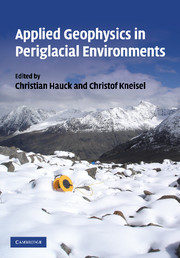Introduction
Published online by Cambridge University Press: 22 August 2009
Summary
Climate warming and its impact on periglacial environments is a research topic of increasing importance, due to the growing concern of warming-induced permafrost degradation and its consequences regarding slope instabilities, construction failure and other hazards related to the melting of ground ice. Periglacial environments are regions with cold, and generally non-glacial conditions, in which frost-related processes and/or permafrost are either dominant or characteristic (French 2007).
Periglacial environments can be highly variable regarding surface and subsurface conditions. The ground thermal regime (e.g. the occurrence of permafrost) depends strongly on altitude, incoming radiation, local climatic conditions and surface and subsurface factors (e.g. organic layers, characteristics of unconsolidated sediments such as coarse blocky material). These often heterogeneous surface and subsurface conditions call for methods that are able to resolve the shallow subsurface at scales between a few metres and several kilometres. Due to the high costs and the logistical difficulties, deep borehole information is scarce and can only be used as point information at special sites. In contrast, geophysical methods are able to characterise the subsurface continuously over larger areas, often with investigation depths down to 100 metres, and can be applied with comparatively little financial and personal effort. Taking into consideration the high costs of drilling, such desirable ground-truthing is seldom possible and can be seen as one of the main reasons for the application of geophysical methods.
- Type
- Chapter
- Information
- Applied Geophysics in Periglacial Environments , pp. xiii - xviPublisher: Cambridge University PressPrint publication year: 2008



